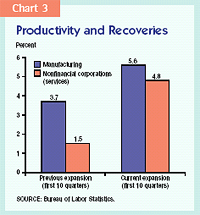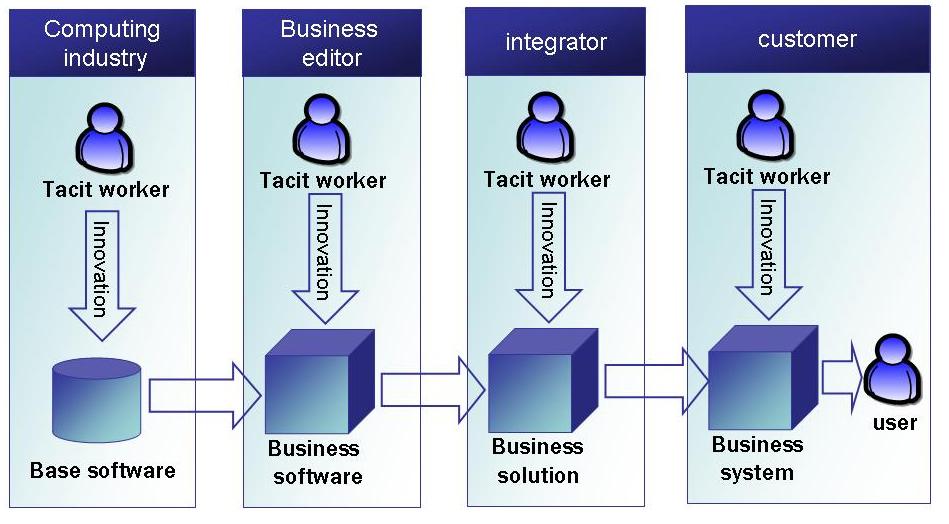The term “post-industrial society” was first coined by Daniel Bell in 1973. He predicted things like the global diffusion of capital, the imbalance of international trade, and the decline of the manufacturing sector on the behalf of service industry. This leads to slow growth economies since services usually show less productivity growth than manufacturing. This is the Baumol Effect which states that in labor-intensive sectors that rely heavily on human interaction or activities, such as nursing,education, or the performing arts, there is little or no growth in productivity over time.
 Yet, the most recent productivity readings show the gap between manufacturing and nonfinancial corporations closing substantially in the current business cycle, one characterized by strong productivity growth. Productivity in nonfinancial services rose at an annualized 4.8 percent in the 10 quarters after the 2001 recession hit bottom that fall, not far below manufacturing’s 5.6 percent. In business cycles dating back to 1970, the factory sector’s advantage was usually wider, with the largest gap occurring in the previous upturn of the early 1990s. Manufacturing gained 3.7 percent in the first 10 quarters of that recovery, more than doubling the 1.5 percent pace for nonfinancial corporations.
Yet, the most recent productivity readings show the gap between manufacturing and nonfinancial corporations closing substantially in the current business cycle, one characterized by strong productivity growth. Productivity in nonfinancial services rose at an annualized 4.8 percent in the 10 quarters after the 2001 recession hit bottom that fall, not far below manufacturing’s 5.6 percent. In business cycles dating back to 1970, the factory sector’s advantage was usually wider, with the largest gap occurring in the previous upturn of the early 1990s. Manufacturing gained 3.7 percent in the first 10 quarters of that recovery, more than doubling the 1.5 percent pace for nonfinancial corporations.
In its report “US productivity after the dot com bust”, McKinsey found that in the US, between 1995 and 1999, 99% of net productivity acceleration and 75% of all positive contributions was accounted by 6 sectors : Wholesale trade, retail trade, security and commodity brokerage, semiconductors, computer manufacturing, telecommunications. Then only few sectors pulled the trend, 3 among them in service industry.
Improving productivity gains in service industry for maintaining a sufficient economic growth is the challenge of the “post industrial societies” especially in Europe which have shown less growth than US. This is possible thanks to ICT industry which has provided innovations, the latest facilitate the processing, storing and sending of information. The technologies allow companies to better manage information, a staple of the service sector.
By their nature, ICT offer network economies—that is, they make services more efficient by connecting people, improving communications and providing information that facilitates day-to-day management. Networks give big companies an edge because the technologies are expensive and only pay off with size. A Federal Reserve study found that nonfinancial multinational corporations in the service sector saw annual productivity gains of 4.5 percent from 1995 to 2000, up from 0.6 percent the previous five years. U.S. companies have only begun to exploit productivity-enhancing technologies, suggesting
the surge in services productivity will continue.
ICT brought innovations on face to face customers, transaction automation and management, decision making, data management and mining, it is a key enabler of productivity growth with other factors like process change, new products, other capital, regulatory changes, surge in service industry productivity.
 The innovation process rely mainly on outside contributors : 2006 IBM CEO annual study shows that for CEO top sources of business innovation are Business
The innovation process rely mainly on outside contributors : 2006 IBM CEO annual study shows that for CEO top sources of business innovation are Business
partners and customers while internal R&D role is declining.
Even if computer industry has produced a lot of various industry solutions which explain surge in US service industry productivity, customers should play a role in getting these solutions for setting efficient internal systems connected to their organisation and their own internal processes.
The capability of identifying and specifying repetitive processes rely on companies tacit workers. It is a prerequisite of successful integrated business system implementation such an ERP, because it often requires a process reengineering.
Yet, european companies are using the same solutions as US with less productivity gains. The reason may be network effect which is less strong in Europe. Since most of companies are SME with usually less investment power than big ones, they could not avoid to change slowly or through a radical creative destruction process. But not only !
In France, between 1984 and 2004, the number of manufacturing non qualified workers fell 20% while the number of service industry workers increase was 55%.
If Europe really want to fuel economic growth, it must reach a strong pace of service industry productivity growth which weight 70% of its economy. It is possible since it requires to be good only in a few subsectors. in some of them, like retail, wholesale trade and security brokerage, a lot has been done in the US. In other sectors like transportation, logistic operations, a lot remains to do, but base technologies are already there.

Bureaucratic activities, like banking, insurance sectors, administration, are still expected innovations to get out of Baumol desease. Though, some service activities like cleaning, nursing and so on, will stay in for a while. Today in Europe, if innovations come slowly comparing to US, it is not du to lack of technology, but to lack of competition. This environment does not urge companies to change for staying in market.

http://www.infosysblogs.com/oracle/
Nice post
Please see this link and post your valuable comments
http://infosysblogs.com/oracle/2008/12/manufacturing_intelligence_fro.html#more